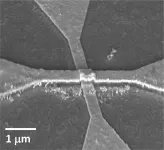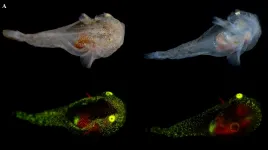(Press-News.org) UC Santa Cruz researchers published a new study--in collaboration with UC Water and the Sierra Nevada Research Institute at UC Merced--that suggests covering California's 6,350 km network of public water delivery canals with solar panels could be an economically feasible means of advancing both renewable energy and water conservation.
The concept of "solar canals" has been gaining momentum around the world as climate change increases the risk of drought in many regions. Solar panels can shade canals to help prevent water loss through evaporation, and some types of solar panels also work better over canals, because the cooler environment keeps them from overheating.
Pilot projects in India have demonstrated the technical feasibility of several designs, but none have yet been deployed at scale. California's canal network is the world's largest water conveyance system, and the state faces both a drought-prone future and a rapid timeline for transitioning to renewable energy. Solar canals could target both challenges, but making the case for their implementation in California requires first quantifying the potential benefits. So that's exactly what researchers set out to do in their paper published by Nature Sustainability.
"While it makes sense to cover canals with solar panels because renewable energy and water conservation is a win-win, the devil is in the details," said Brandi McKuin, lead author of the new study and a UC Santa Cruz postdoctoral researcher in environmental studies. "A critical question was whether the infrastructure to span the canals would be cost-prohibitive."
Canal-spanning solar panels are often supported either by steel trusses or suspension cables, both of which are more expensive to build than traditional support structures for ground-mounted solar panels. But McKuin led a techno-economic analysis that showed how the benefits of solar canals combine to outweigh the added costs for cable-supported installations. In fact, cable-supported solar canals showed a 20-50 percent higher net present value, indicating greater financial return on investment.
In addition to benefits like increased solar panel performance and evaporation savings, shade from solar panels could help control the growth of aquatic weeds, which are a costly canal maintenance issue. Placing solar panels over existing canal sites could also avoid costs associated with land use. Now that the new paper has provided a more concrete assessment of these benefits, members of the research team hope this could lead to future field experiments with solar canals in California.
"This study is a very important step toward encouraging investments to produce renewable energy while also saving water," said Roger Bales, a coauthor on the paper who is a distinguished professor of engineering at UC Merced, the former director of the Sierra Nevada Research Institute, and a director at UC Water.
Bales was part of the original group that got the project started in 2016, when San Francisco-based social impact agency Citizen Group approached UC Solar and UC Water with the concept. From there, the research grew into a collaboration between UC Merced, UC Santa Cruz, and Citizen Group, with funding support from NRG Energy and the USDA National Institute of Food and Agriculture.
Lead author Brandi McKuin started working on the project while completing her Ph.D. at Merced, then continued with help from senior author and UCSC professor Elliott Campbell, the Stephen R. Gliessman Presidential Chair in Water Resources and Food Systems and a fellow Merced transplant. UC Merced professor Joshua Viers and researcher Tapan Pathak advised on the project, and graduate students Andrew Zumkehr and Jenny Ta contributed to analysis.
Zumkehr led a complex hydrological analysis using data from satellites, climate models, and automated weather stations to model and compare evaporation rates at canal sites across the state, with and without shade from solar panels. McKuin then used this information in her assessment to calculate the financial benefits of reduced evaporation.
Ultimately, it was the cost savings of many combined benefits that made solar canals financially viable, rather than benefits from reduced evaporation alone. But the study also notes that benefits from deploying solar canals could extend beyond immediate financial impacts. For example, every megawatt of solar energy produced by solar canals in California's Central Valley has the potential to replace 15-20 diesel-powered irrigation pumps, helping to reduce pollution in a region with some of the nation's worst air quality.
And senior author Elliott Campbell says the wide range of benefits identified by the paper is, in itself, an important lesson to carry forward. He sees the findings as not only an assessment of solar canals, but also a clear illustration of the interconnections between urgent global issues like air quality, energy, and water conservation.
"What we're seeing here is actually some surprising benefits when you bring water and energy together," Campbell said. "Sometimes it leads to a smoother landing in how we transition to better ways of making energy and saving water."
INFORMATION:
Training neural networks to perform tasks, such as recognizing images or navigating self-driving cars, could one day require less computing power and hardware thanks to a new artificial neuron device developed by researchers at the University of California San Diego. The device can run neural network computations using 100 to 1000 times less energy and area than existing CMOS-based hardware.
Researchers report their work in a paper published Mar. 18 in Nature Nanotechnology.
Neural networks are a series of connected layers of artificial neurons, where the output of one layer provides the ...
From swallowing pills to injecting insulin, patients frequently administer their own medication. But they don't always get it right. Improper adherence to doctors' orders is commonplace, accounting for thousands of deaths and billions of dollars in medical costs annually. MIT researchers have developed a system to reduce those numbers for some types of medications.
The new technology pairs wireless sensing with artificial intelligence to determine when a patient is using an insulin pen or inhaler, and flags potential errors in the patient's administration method. "Some past work reports that up to 70% of patients do not ...
A study by Monash University has uncovered that liver metabolism is disrupted in people with obesity-related type 2 diabetes, which contributes to high blood sugar and muscle loss - also known as skeletal muscle atrophy.
Using human trials as well as mouse models, collaborative research led by Dr Adam Rose at Monash Biomedicine Discovery Institute has found the liver metabolism of the amino acid alanine is altered in people with obesity-related type 2 diabetes. By selectively silencing enzymes that break down alanine in liver cells, high blood sugar and muscle loss can be reversed by the restoration of skeletal muscle protein synthesis, a critical determinant of muscle size and strength.
The research, published today in Nature Metabolism, has shown the altered liver metabolism ...
Scientists have witnessed bonobo apes adopting infants who were born outside of their social group for the first time in the wild.
Researchers, including psychologists at Durham University, UK, twice saw the unusual occurrence among bonobos in the Democratic Republic of Congo, in central Africa.
They say their findings give us greater insight into the parental instincts of one of humans' closest relatives and could help to explain the emotional reason behind why people readily adopt children who they have had no previous connection with.
The research, led by Kyoto University, in Japan, is published in the journal Scientific Reports.
Researchers observed a number of bonobo groups over several years in the Wamba area of ...
Researchers at Seattle's Institute for Systems Biology and their collaborators looked at the electronic health records of nearly 630,000 patients who were tested for SARS-CoV-2, and found stark disparities in COVID-19 outcomes -- odds of infection, hospitalization, and in-hospital mortality -- between White and non-White minority racial and ethnic groups. The work was published in the journal Clinical Infectious Diseases.
The team looked at sociodemographic and clinical characteristics of patients who were part of the Providence healthcare system in Washington, Oregon and California. These ...
Metformin, a drug used to treat type-2 diabetes, could help reduce chronic inflammation in people living with HIV (PLWH) who are being treated with antiretroviral therapy (ART), according to researchers at the University of Montreal Hospital Research Centre (CRCHUM).
Although ART has helped improved the health of PLWH, they are nevertheless at greater risk of developing complications related to chronic inflammation, such as cardiovascular disease. These health problems are mainly due to the persistence of HIV reservoirs in the patients' long-lived memory T cells and to the constant activation of their immune system.
In a pilot study published recently in ...
MADISON, Wis. -- Scientists at the University of Wisconsin-Madison have developed a way to use a cell's own recycling machinery to destroy disease-causing proteins, a technology that could produce entirely new kinds of drugs.
Some cancers, for instance, are associated with abnormal proteins or an excess of normally harmless proteins. By eliminating them, researchers believe they can treat the underlying cause of disease and restore a healthy balance in cells.
The new technique builds on an earlier strategy by researchers and pharmaceutical companies to remove proteins residing inside of a cell, and expands on this system to include proteins ...
For the first time, scientists have documented biofluorescence in an Arctic fish species. The study, led by researchers at the American Museum of Natural History who spent hours in the icy waters off of Greenland where the red-and-green-glowing snailfish was found, is published today in the American Museum Novitates.
"Overall, we found marine fluorescence to be quite rare in the Arctic, in both invertebrate and vertebrate lineages," said John Sparks, a curator in the American Museum of Natural History's Department of Ichthyology and one of the authors of the ...
The ongoing COVID-19 pandemic changed the higher education experience for students across the United States, with more than 90 percent of institutions reporting a shift in education delivery with the arrival of COVID-19.
The rapid transition to remote study came with its own learning curve for students and faculty alike. But for many students with disabilities, the shift offered new educational modalities as well as challenges - and the hope that some changes will continue after the threat of the virus subsides.
"This was a really unique, historical moment," says Nicholas Gelbar '06 (ED), '07 MEd, '13 Ph.D., an associate research professor with the Neag School of Education. "Remote learning, ...
Millions of children weighing less than 15kg are currently denied access to Ivermectin treatment due to insufficient safety data being available to support a change to the current label indication. The WorldWide Antimalarial Resistance Network (WWARN)'s new meta-analysis published today provides evidence that supports removing this barrier and improving treatment equity. ...

